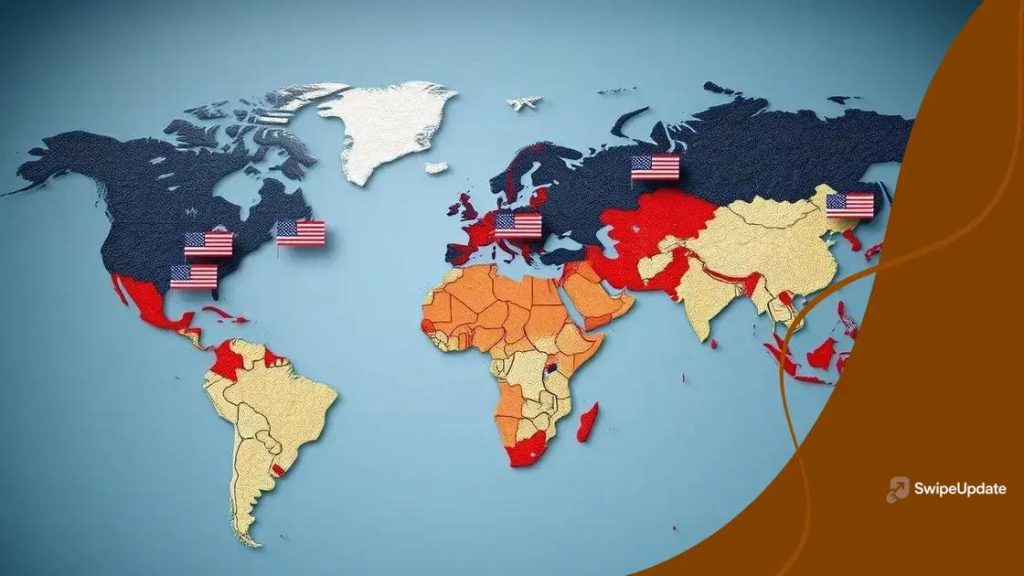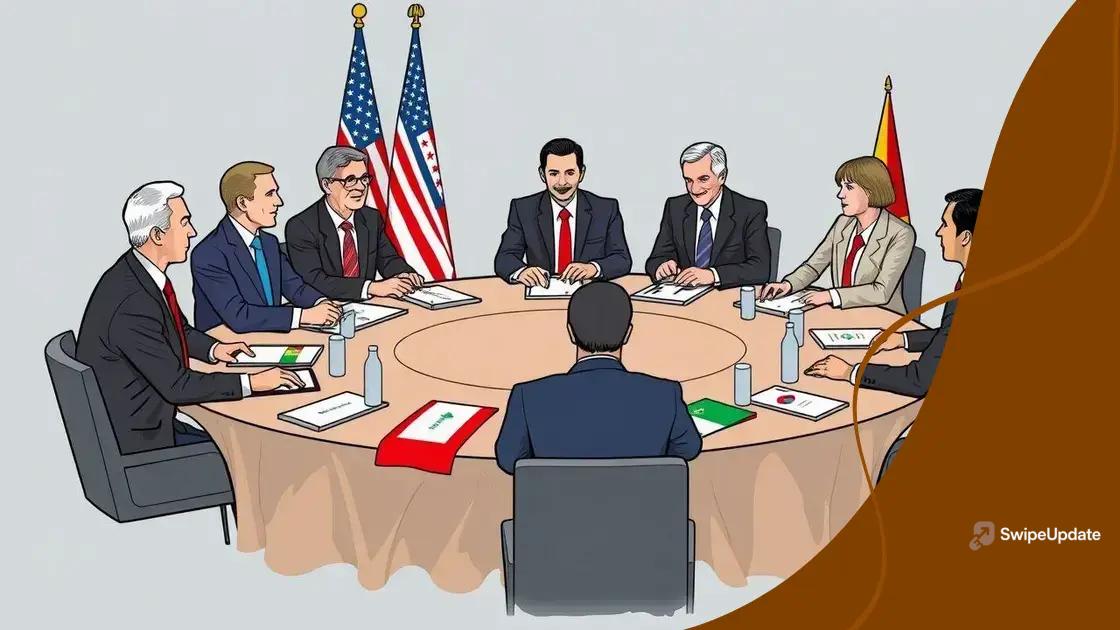US stance on international conflicts: a closer look

The US stance on international conflicts prioritizes diplomacy and strategic alliances while adapting military strategies to address evolving global threats and maintain peace and stability.
The US stance on international conflicts has significant implications for global peace and stability. Understanding its motivations can reveal much about the course of world events and how countries interact. What influences these decisions, and how do they shape our collective future?
Historical context of US involvement
The historical context of US involvement in international conflicts is essential to understanding its current foreign policy. Over the years, the United States has engaged in various conflicts around the globe, each shaped by its unique historical backdrop.
One of the earliest examples is World War I, where the US entered late, contributing to the shift in power dynamics. This set a precedent for future involvement and marked a change in how the US viewed its role on the world stage.
The role of WWII
World War II further solidified the US’s place as a global leader. After the war, the US helped to establish the United Nations, focusing on promoting peace and security worldwide. This involvement matured US foreign policy, emphasizing diplomacy alongside military action.
- Formation of NATO in 1949 to counter Soviet influence.
- Intervention in the Korean War to prevent the spread of communism.
- Involvement in the Vietnam War raised questions about US foreign policy.
As the Cold War unfolded, the US adopted a policy of containment, which justified involvement in numerous conflicts across the world. The implications of these actions reverberated through history, as the US aimed to balance power and protect its interests.
Shifts in strategy
In the late 20th century, events like the Gulf War highlighted a shift in US strategy. The quick military response showcased the power of modern technology and emphasized the importance of international coalitions.
The 9/11 attacks marked a turning point, propelling the US into the War on Terror. This initiated prolonged military engagements in Afghanistan and Iraq, driven by the goal of combating terrorism and ensuring national security.
Understanding the historical context behind US involvement in conflicts is crucial. It reveals the motivations and consequences that continue to shape today’s foreign policy decisions.
Key international conflicts involving the US
The key international conflicts involving the US are critical to understanding its foreign relations. These conflicts showcase the shifting landscape of global politics and highlight the role the US plays on the world stage.
One significant event is the Vietnam War, which had profound implications on US military strategy and public opinion. This conflict raised vital questions about intervention and national ethics, impacting policies for years to come.
The Gulf War
Another major conflict was the Gulf War of the early 1990s. It marked a new era of military engagement, emphasizing rapid deployments and high-tech warfare. The coalition led by the US successfully liberated Kuwait, demonstrating a united response to aggression.
- Operation Desert Storm was a swift military action.
- Media coverage shaped public perception of the conflict.
- The war highlighted the importance of international coalitions.
Moving into the 21st century, the War on Terror following the September 11 attacks altered the US’s approach to global conflicts. This initiated prolonged military engagements in Afghanistan and Iraq, driven by the need to confront terrorism and ensure national security. These conflicts stirred debate over ethics, strategy, and the long-term impacts of military interventions.
Modern implications
Today, the US involvement in conflicts such as those in Syria and Ukraine continues to reflect its strategic interests and alliances. These situations often evoke discussions about the balance between diplomatic solutions and military action. Understanding these interactions is crucial as global dynamics evolve rapidly, highlighting the US’s role in stabilizing regions and supporting allies.
The role of diplomacy in US foreign policy

The role of diplomacy in US foreign policy is crucial for maintaining global stability. Through diplomatic efforts, the US seeks to foster positive relationships with other nations, aiming for peaceful resolutions rather than military confrontations.
Diplomacy allows the US to engage with allies and adversaries alike. It often starts with dialogue and negotiations, emphasizing collaboration. For instance, treaties and agreements, such as the Paris Agreement on climate change, showcase how diplomacy can address global challenges.
Methods of diplomacy
The US employs various methods in its diplomatic efforts. These can include:
- Formal treaties that codify agreements between nations.
- Summits where leaders meet to discuss critical issues.
- Multilateral negotiations involving multiple countries to resolve issues affecting many.
Moreover, public diplomacy plays a vital role in shaping perceptions abroad. By disseminating information and promoting cultural exchange, the US can build goodwill and trust with foreign populations. Such efforts can foster understanding, influencing foreign opinions positively.
Challenges in diplomacy
Despite its importance, diplomatic efforts often face challenges. Its effectiveness can be hindered by political unrest, cultural differences, and competing national interests. For example, during international crises, such as the Syrian civil war, diplomatic solutions can be complicated, requiring sensitive negotiations and a willingness to compromise.
The US approach to diplomacy is constantly evolving. It seeks to adapt to global changes while balancing assertiveness and cooperation. Understanding the complex role that diplomacy plays helps us appreciate how international relations shape our world today.
Impact on global alliances and partnerships
The impact on global alliances and partnerships due to US foreign policy is significant. These alliances shape international relations and influence how nations work together to tackle shared challenges.
One of the most notable alliances is NATO, established in 1949. The US plays a vital role in this organization, promoting collective security among member nations. NATO’s commitment to mutual defense is a cornerstone of US foreign policy, ensuring that allies support each other in times of need.
Regional partnerships
In addition to NATO, the US is involved in various regional partnerships. For example, relationships with countries in the Asia-Pacific region focus on economic and security cooperation. Here are some key aspects of these partnerships:
- Joint military exercises to ensure readiness against potential threats.
- Economic agreements that enhance trade benefits for member countries.
- Shared intelligence systems to combat terrorism and cyber threats.
These partnerships are crucial as they allow the US to maintain influence and stability in important regions. Moreover, strengthening relationships helps improve global trade and fosters diplomatic dialogues. Similarly, collaborations in initiatives such as climate agreements show a commitment to addressing global issues cooperatively.
Challenges to alliances
However, the impact of US foreign policy on global alliances is not without challenges. Diverging interests and political changes within member nations can strain these relationships. For instance, varying responses to crises, like the pandemic or conflicts, can test commitment levels among allies.
Ultimately, the impact on global alliances reflects the complexity of international relations. As the global landscape continues to change, the role of the US in shaping these partnerships remains essential for maintaining peace and stability worldwide.
Future implications of US military strategy
The future implications of US military strategy are vital for shaping global stability and security. As the world evolves, so too must the approaches adopted by the US military. This evolution aims to address both new challenges and persistent threats.
One significant change involves the shift towards technology-driven warfare. The integration of artificial intelligence and advanced technologies into military operations will likely redefine engagement methods. For instance, the use of drones and cyber capabilities enhances the ability to respond quickly and effectively to emerging threats.
Focus on deterrence
Another key aspect is the emphasis on deterrence. The US will prioritize maintaining a credible defense posture to prevent potential adversaries from acting aggressively. This includes modernizing nuclear arsenals and strengthening alliances with countries that share similar security interests.
- Enhancing missile defense systems to protect allies.
- Increasing joint exercises with partner nations.
- Developing new strategies to counter cyber warfare.
As the geopolitical landscape shifts, the US must also navigate complex relationships with major powers like China and Russia. Engaging in diplomatic efforts while preparing for conflicts will be crucial. This dual approach can enable the US to project strength while avoiding unnecessary military confrontations.
Challenges ahead
Looking forward, there are challenges that the US military strategy will face. Budget constraints and political divisions may affect strategic priorities. Additionally, adapting to asymmetrical threats, such as terrorism and hybrid warfare, will require innovative thinking and flexible responses.
Ultimately, the future implications of US military strategy will significantly impact international relations. Clearly, aligning capabilities with current realities is essential for maintaining security and promoting global peace.
FAQ – Questions about US Stance on International Conflicts
What is the US stance on diplomacy in international conflicts?
The US emphasizes the importance of diplomacy to foster positive relations and resolve conflicts through dialogue rather than military action.
How do international alliances impact US foreign policy?
International alliances, like NATO, help shape US foreign policy by promoting collective security and mutual support among member nations.
What role does technology play in US military strategy?
Technology is increasingly integrated into US military strategy, enhancing capabilities like drone warfare and cyber defense for faster responses to threats.
What challenges does the US face in maintaining global partnerships?
The US faces challenges such as political disagreements, different national interests, and complex geopolitical issues that can strain partnerships.
